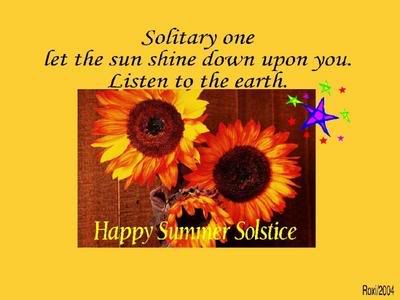(no subject)

Litha is the long awaited arrival of summer! The weather is warm and Mother Earth shows off her beautiful offspring in full bloom. When it is so very hot and dry, why not go out with a bunch of people and have a water fight, or a balloon toss? The woodland spirits such as dryads, nymphs and fairies are quite active at this time...run with them and play, you can learn much. Gather your herbs, they will be dried in time for the next holiday.
Also known as Midsummer, Sonnenwnde, Summer Solstice, and Feill-Sheathain. Next to midwinter, this is the best time for picking mistletoe, traditionally from an Oak tree. In some traditions, this is when the "weird" half of the God is born - the Holly King. This is the "height" of the Sun God's power. This is the night of the Green Man, who was supposed to playharmless (if not annoying) tricks on people. Healings and love magick are especially suited to this time. In some places a boy in green went from house to house, collecting wood for the midsummer's fire. Many sacrificial enactment's of the Green Man were done, many including him being symbolically burnt in some way.
This Sabbat shares mythical elements with both Beltane and Lammas in its themes of fertility and death. Litha, also called Midsummer and Summer Solstice, celebrates the abundance and beauty of the Earth. This is the longest day of the year, and will fall somewhere between the dates above depending on when the Sun is at its northern most point. From this day on, the days will wane, growing shorter and shorter until Yule. The trees and fields are full and prosperous. The young animals and birds are learning to frolic in the fields and trees. This is a time of the Faery, when a festival called the Feast of the Faery is held. It is believed that at twilight on this day, the portals between worlds open and the Faery folk my pass into our world. Welcome them on this day and they may bless you with their wisdom and joy. This is a time to look internally at the seeds you've planted that should be at full bloom.
Litha, or Mid-Summer is the holiday that is seen as the peak of the power of the God of Light. This representation of the God is often known as the Oak King. Mid-Summer is the beginning of the Summer Solstice. It is the longest day of the year. At this time, the God of Light is at his highest strength and at the peak, he crests and gives way to his twin, the God of Darkness (not evil or satanic), often known as the Holly King. Rituals depicting these two kings in a battle are often depicted. Many see them as two rival personalities within the same Deity.
The Oak King is born at Yule, the Winter Solstice. He gains strength with the nights
growing shorter and the days longer. At the moment of his greatest power, Litha
(Mid-Summer), he confronts himself in the mirror and sees the other side of his
personality, the Holly King. The Holly King is born at Mid-Summer. He gains strength
until Yule, the night of his greatest power, the longest night. At that point, he then looks
in the mirror and sees the other side of himself, the Oak King.
There are many versions of this lore. One viewpoint has a Christian tone. This view sees Jesus Christ as the Holly King, while John the Baptist is seen as the Oak King. One reason for this identification is the fact that the birth of Christ is celebrated on December 25th, and the birth of John the Baptist is celebrated at the Summer Solstice.
Consider decorating your environment with fir boughs, birch, fennel, and lily. Sun
flowers are an obvious here as well. This is a good time of year to work with increasing
strength and focus, clarity and fertility. This is also the time when many believe that the
Faeries come out to play and that they speak in the human tongue. For many, this is the
Faerie high holiday.
Midsummer is, of course, a fire festival and has at times been called Beltane as both Sabbats usually have bonfires lit during the rites. The traditions of jumping the fire and driving cattle between two bonfires are observed the same as for Beltane. In some areas, a solar wheel would be set ablaze and rolled down a hill as a symbol of the sun's power. In more ancient times, Druids would gather mistletoe in the oak groves, for mistletoe without the berries was viewed as an amulet of protection. Amulets which have lost their usefulness were traditionally destroyed on this day as well. The worn-out amulets were cast into the Sabbat fire, with the respect due them, to be destroyed. The ashes were then scattered to bring blessings to the land. Customs also mention that women should walk naked through their gardens to ensure continued fertility for the season of growth.
Wicca is often seen as having a basis of the spiral of life, representing the never ending
circle of death and rebirth. The duality of our religion encourages us to be aware of that
which balances. Many of our high holidays remind us that dichotomies do not really
exist. Where there is death, there is life. Where there is Light, there is Dark.
Remember that at the height of its power, the Light has already begun its journey into Darkness...